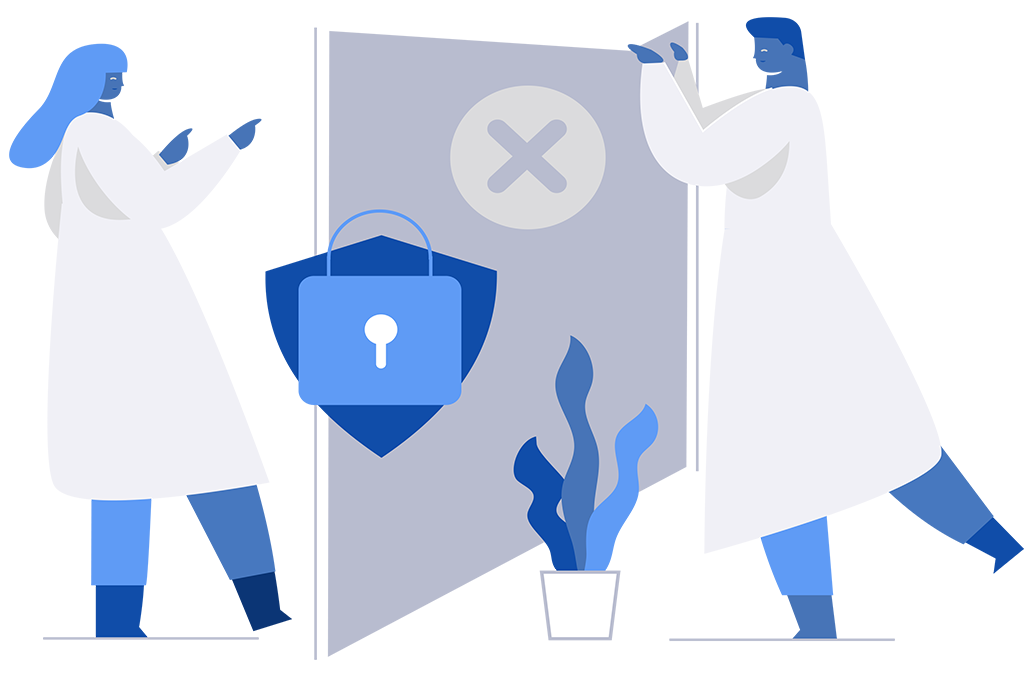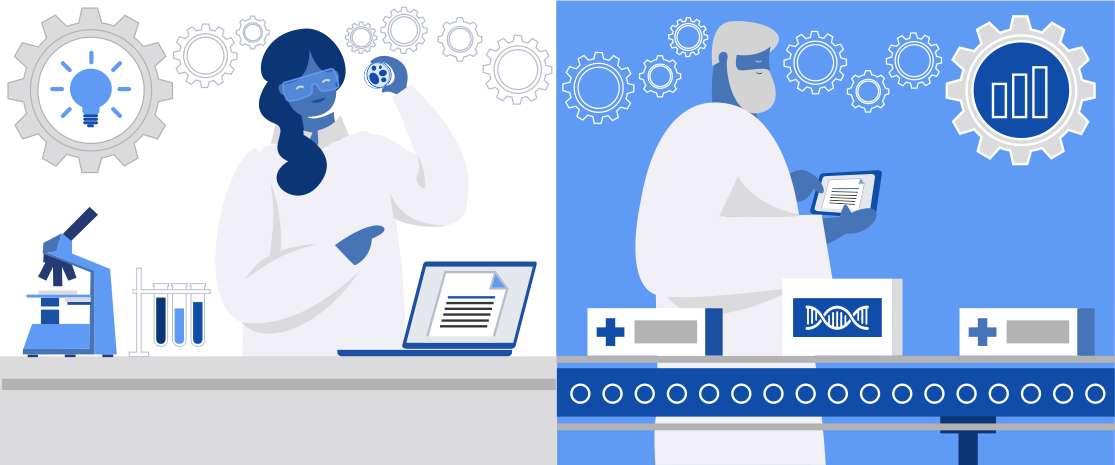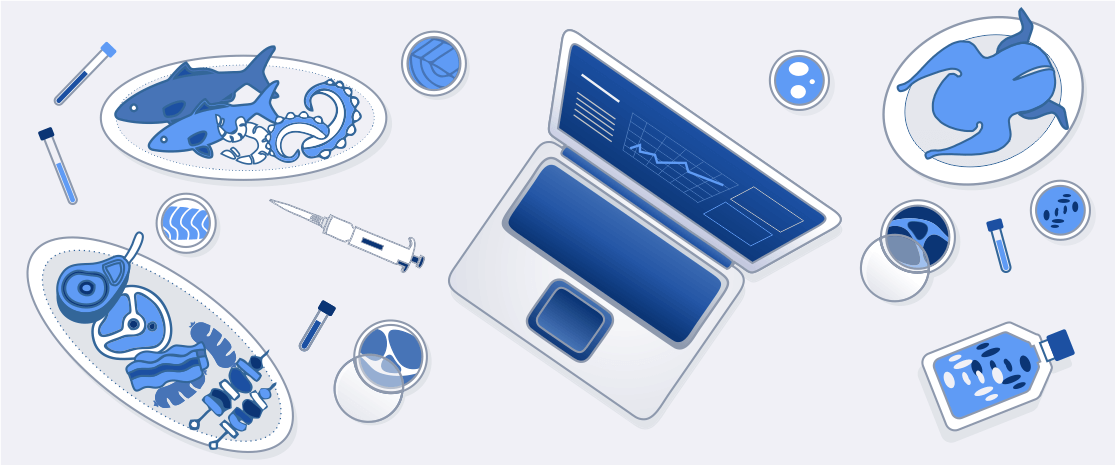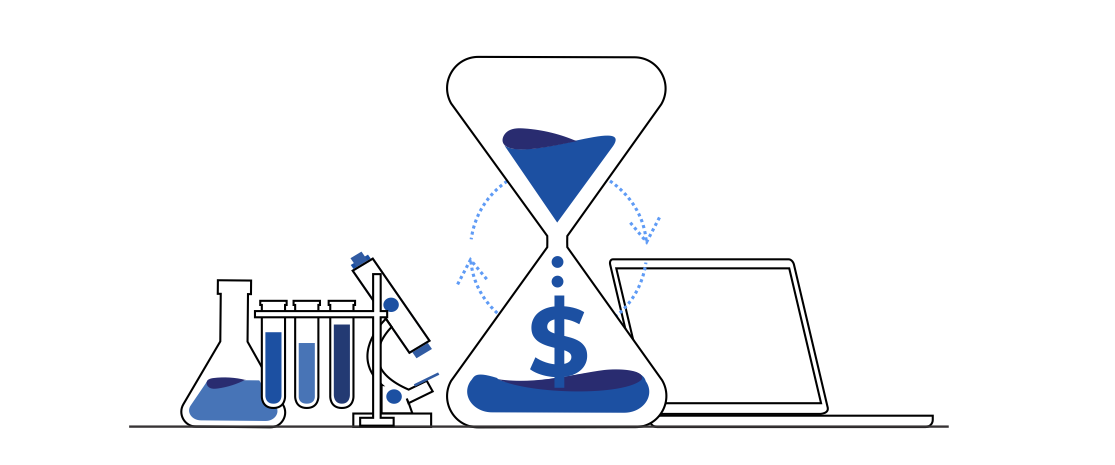Patenting, IP and the role of ELNs explained
Disclaimer: This article is intended for informational purposes only and does not substitute legal advice, nor does it aim to do so, therefore should not be taken as such. Please consult with your legal advisors for any legal-related matters.
Table of contents:
- Understanding IP (Intellectual property)
- Patents
- The concepts of “first-to-file”, “first-to-invent” and “prior art”
- Has the role of (electronic) notebooks diminished in the “first-to-file” era?
- Guidelines on how to protect your intellectual property
- This is how an electronic lab notebook (ELN) can help you protect your IP
Understanding IP (Intellectual property)
Intellectual property refers to creations of the mind – inventions, literary and artistic works, and symbols, names and images used in commerce.
Intellectual property rights allow their owners to benefit from the work or investment they have put into a creation. They help the inventors keep their product’s competitiveness on the market, which compensates for the investments made while developing the creation, and provides the means to conduct further research.
The creations of intellectual property contribute to the general well-being of our society and propel the global economy by, among other things, creating new industries and jobs.
Intellectual property rights on one hand provide consumers with certainty that they are buying safe and quality products, and on the other hand offer a strong incentive for researchers and innovators to come up with new ideas and creations to make headway for the world at large.
Patents
Patent is a commonly known intellectual property right that is widely applicable to scientific research, as it dictates the usage and commercialization of research findings. Most of the time, we associate patents and patenting with protecting our rights to the invention, secrecy around information, assuring profits by commercializing the invention, and preventing copycats from profiting with our ideas and products. We also associate patents with increasing competitive advantage on the market and sometimes even with creating obstacles to our competitors.
However, we often forget that the original intention of patents was to stimulate innovation. Not to protect and hide, but to share. In return for sharing the invention with the world and therefore contributing to the progress, the patent holder gets granted a period of exclusivity during which he/she has exclusive rights to commercialize the invention.
Practically all industrial sectors are nowadays highly competitive, and laboratories are not an exception. Having control over your intellectual property is of utmost importance.
That is why labs must consider the legal nature of their work in order to ensure protection of their discoveries – not only in the process of filing a patent, but in the record keeping process as well.
Patents are generally based on the following principles:
- They are exclusive
This means that the invention owner has the right to decide who may – or may not – use the patented invention for the period during which it is protected. - They are applicable only for economic activity
Use for personal or other non-economic activities does not fall under the patent protection. - They are territorial
Patents apply only to countries or regions where they were granted. - They are time-limited
Industrial property rights (except for trademarks and geographical indications) are protected for a period of time that has been prescribed with applicable legislation.
Patents protect inventions, i.e., products and processes, that are from all areas of technology, which are considered to be new, inventive, and industrially advantageous. In case such an invention has already been described in any body of existing knowledge, which is termed “prior art”, the invention is not going to be patentable. As a general rule, scientific theories, mathematical methods, plant or animal variety, discoveries of natural substances, commercial methods or methods of medical treatment (as opposed to medical products) are usually not patentable. Protection is granted for a limited period, generally 20 years. In some cases (e.g., with drugs where clinical trials often take up more than 10 or 15 years), this period might be extended for additional 5 years.
If you would like to file a patent application, you will need to have neatly prepared documentation. This may include things like the title of invention with an indication of its technical field, supported with the background and a description of the invention. It has to be written in clear language with enough supplementary material (such as drawings, plans or diagrams) to allow for reproduction of the invention. Every patent application also needs to have well defined claims, which establish the scope of your invention rights.
As with other types of industrial property rights, patents are territorial. They are granted by national patent offices or regional offices. The latter have been formed to make the process of patenting in several countries at the same time easier and more efficient. An example of such regional offices is the European Patent Office (EPO). They examine the patent application for a group of countries which then individually decide whether they are going to offer patent protection within their borders. In case of EPO these are EPO member states. As the USA is an important market and economy, the United States Patent and Trademark Office (USPTO) is a frequently used patent office.
In the end, there is no such thing as an “international patent;” this always comes down to either national or regional authority. However, by filing one international patent application under the Patent Cooperation Treaty (PCT), applicants can simultaneously seek protection for an invention in a large number of countries, which can facilitate the patent granting decisions for the national or regional patent offices.
Patented inventions can cover a broad range of products and processes, such as toys, appliances, tools, manufacturing processes, software, types of biological materials, medical devices, pharmaceutical drugs, etc. Biotechnology has gained increasing importance over the years, and is considered to be one of the key technologies that will help enable the long‐term sustainable development of our economy and help with public health and environmental protection.
There is an increasing need to keep up with the technological advances made in recent years. They opened new opportunities to conduct research and delve deeper into the most complicated of topics. Computational tools offer a new range of analysis that provide us with meta conclusions not achievable in the past. This calls for better management of all the data we generate, and more efficient collaboration. It stresses the importance of gathering the data in one place, which facilitates its evaluation, and makes room for new conclusions and inventive ideas.
Here is where electronic lab notebooks, such as SciNote, can play a crucial role.
The concepts of “first-to-file”, “first-to-invent” and “prior art”
When dealing with patents, one quickly stumbles upon these expressions. We tried to summarize their meanings here.
Originally, patent offices across the globe used the “first-to- invent” approach when it came to filing patent applications. However, the majority of countries have switched to the “first-to-file” approach. One of the last patent offices to do so was the USPTO with the America Invents Act (AIA) that came into force on March 16th, 2013. All patent applications filed or updated at USPTO after this date are processed under this act, while applications filed before this date were processed under the old, “first-to-invent” rules.
What is the difference between “first-to-invent” and “first-to-file”?
The “first-to-invent” approach means the following: in case more than one inventor filed a patent application for the same invention, the patent would be granted to the inventor who was able to prove that the invention was conceived (moment when a specific idea of an invention formed in the inventor’s mind) and reduced into the practice (when the inventor either constructed a physical embodiment of the invention which is demonstrated to another person and is workable for its intended or when inventor filed a patent application) first – even if this inventor filed the patent application after other inventors. There is more complexity to this matter, but for the purpose of general understanding, this is enough. As you probably can imagine, proving who invented something first can be very complex and not an easy undertaking.
The “first-to-file” approach means that the patent for an invention is granted to the first inventor that files a patent application, regardless of the date of actual invention. This makes the filing of a patent application simpler, as it is generally easier to determine who filed the invention first rather than who invented it first.
In the USA the “first-to-file” approach enforced by AIA is slightly different than in other countries as it allows a 12-month grace period, during which the inventor can publicly disclose the invention (e.g., publish a peer reviewed paper) and can still file for a patent. This public disclosure will not be counted as “prior art”. Therefore, this approach is sometimes termed “first-inventor-to-file” or “first-to-disclose”. In contrast, the EPO and many other national patent offices do not have the concept of grace period.
And finally, what is “prior art”? One of the requirements for the invention to be granted a patent is the novelty of the invention. This means that no evidence about your invention is known before the patent application filing date. The notion of prior art is similar in the EPO and USPTO but they do have some differences, which are also documented by both offices.
As explained above, the USPTO recognizes a 12-month grace period for the inventors related to the prior art of their inventions.
Has the role of (electronic) notebooks diminished in the “first-to-file” era?
As the majority of national and regional patent offices’ work in line with the “first-to-file” approach when it comes to granting patents, it is in most cases no longer possible to use the (electronic) laboratory notebook data to prove an earlier date of invention and therefore oppose another competitive patent application. So, does this mean we can become sloppier with documenting our work?
Well-documented data in an electronic laboratory notebook continues to provide value in several stages of the inventive process and patent application.
The information in a lab notebook is still useful for patent offices as well as in courts, for example to provide the following information:
- Provide evidence who are the inventor(s) of a patent
- Prove who is the owner of the invention (e.g., that it was not originated outside your team/company)
- To establish the rights to a trade secret, in cases you decided not to protect your intellectual property with e.g., a patent application.
To a large extent, electronic laboratory notebooks such as SciNote do that with great efficiency.
Guidelines on how to protect your intellectual property
Perhaps the most important point to keep in mind related to protecting intellectual property in the “first-to-file” era is that the date when invention was conceived is no longer important. The date when the invention was either publicly disclosed by someone (you or your competitor) or the date when the invention was filed as patent application (by you or your competitor) took the lead.
Therefore, it is important to monitor your patent landscape and the publications in your field for patent applications or other applications to your invention that constitute prior art. Internally you should have a system in place where you can keep a close eye on who has the access to the information in your lab that you intend to file as a patent application at some point.
Make sure only the authorized people who should have access to certain data actually have access, and that the information is not unintentionally published. Ideally, you should have an efficient process of identifying potential inventions and a quick decision-making process about leveraging their value: filing for a patent application, or not.
This should drive your next actions either towards a speedy patent application or towards publishing the invention in some form and contributing to the prior art in your field, therefore avoiding any competitors to file a patent and blocking your research and development or business.
An electronic laboratory notebook can play an important role in helping you to save time and keep this process efficient.
This is how an Electronic Lab Notebook (ELN) can help you protect your IP
As an electronic lab notebook, SciNote can help you protect your IP in the following ways:
- It allows you to keep all your data in one place in a structured way. Having your IP i.e., your data scattered around in different forms and places is not what you want. SciNote keeps it all together and organized for you, enabling you to separate sensitive information.
- It allows you to control the access of users to the information. Make sure that only the people who should have access to information have it. A good practice would be to keep the work that you consider to be patentable separated in dedicated project(s), and control who has the access and what level of access they have. SciNote’s built-in structure and access control helps you with that.
- It automatically links different types of information, keeping records of your work (e.g., linking results with protocols and users who contributed to the electronic record) and offers additional data annotations.
- It helps you track who created which information and performed which actions and when.
- SciNote enables you to execute your formal procedures for entering data, locking access, signing and witnessing electronic records with all activity timestamped, tracked and logged with an audit trail (timestamped log of all changes in SciNote). These capabilities will help you to document who authored entries and when and eventually help you establish who the inventors are. Audit trails, time stamps work out of the box in SciNote, while the use of signing and witnessing is up to your needs and internal policies; however, they might be useful, even if you are not required to use them as you do not work in a GxP compliant setting. It is advised that witnessing is done by people that understand the subject matter.
- Allows you to control and limit changes to electronic records by using different roles on projects and by ability to lock electronic records to prevent further unsupervised edits.
- With SciNote you control who owns the content/data. Probably the most important aspect of keeping your intellectual property – SciNote doesn’t claim any ownership over your research data therefore it is up to your processes and policies to control data ownership on your end.
- SciNote keeps your data safe and secure. SciNote has several levels of security, and we prioritize keeping your records safe. Our hosted solutions also come without-of-the-box backups. Check out our data protection white paper here.
Author: Matjaž Hren, Vice President of Product Management at SciNote
Download SciNote's Data Protection White Paper
Need more clarity on how SciNote protects your data?
Download PDF





